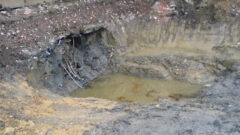
NASA’s building new tools to help manage the effects of climate change
When most of us think of NASA, we think of probes heading for deep space or the men who walked on the moon. The organisation, however, has been busy developing technology that will benefit us closer to home, in the form of the Airborne Snow Observatory.
Managing water
Following a late snowfall in the Sierra Nevada mountains, NASA researchers took the first flight of the season in the Airborne Snow Observatory (ASO). The craft has a pair of sensors that point through a glass cut-out in its base and measure the volume of the mountain snowpack while a spectrometer provides a highly accurate estimate of the volume of water runoff come spring.
The data, which also predicts when the mountain water will flow through California’s aqueducts and reservoirs, enables the authorities to manage the water used to charge hydroelectric power plants. As the state – which is home to some of America’s most productive agricultural regions – faces alternating droughts and flooding due to the effects of climate change, this careful management is becoming ever more critical.
The technology
The plane’s sensors emit pulsed laser beams myriad times per second, which sweep laterally across the landscape and measure the time it takes for the beams to reflect from the surface of the snow and return to the sensors. Software is then able to plot a 3D map of the snow surface, which when combined with earlier observations, is used to calculate the total volume of water stored in the watershed at that point. This is referred to as the snow-water equivalent.
Fresh snow is highly reflective, helping to throw heat back into the atmosphere and slowing the melt. As the snowpack becomes less reflective due to the growth of ice crystals and the build up of air pollution, melting quickens. The shifts in reflectivity are what enables the team to calculate when the water will reach California’s reservoirs.
The future
NASA’s ultimate aim is to measure the volume of water in snow from space. This could help a host of other regions like California that are facing water challenges to predict and account for the shifts. In the longer term, the program could provide information on the planet’s overall shifting reflectivity, thus offering feedback on the progression and rate of climate change globally.
Where R&D comes in
Such technologies require effort from businesses and organisations across the globe. Those in the UK can benefit from tax relief – take a look at our R&D Tax Credits Explained document to find out more.
If your business has been involved in research and development for environmental technologies and hasn’t considered claiming relief from HMRC, you can get an estimate of what you may be owed with our R&D tax credit calculator. R&D Tax Solutions specialises in helping companies in engineering, software and other industry sectors to claim R&D tax credits for innovative projects.





